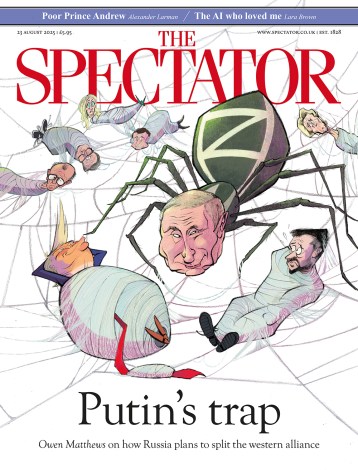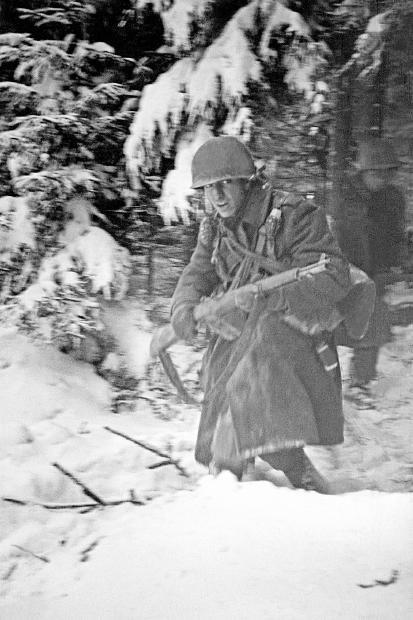Christmas Eve 1944 found thousands of Allied — mostly American — troops dug into trenches and foxholes along the Belgian front, where they sucked at frozen rations and, in some places, listened to their enemies singing ‘Stille Nacht’. Their more fortunate colleagues in command posts gathered around Christmas trees decorated with strips of the aluminium foil more usually dropped from planes to jam enemy radar signals. The following morning a wave of Junkers dropping magnesium flares led the German Christmas Day onslaught, soon answered by American P-47 Thunderbolt fighter bombers, dropping napalm ‘blaze bombs’ or strafing with machine guns.
On the ground, following reports of appalling atrocities, the battle was increasingly fought with ‘savage hatred’ on both sides. General Patton’s promised breakthrough had yet to materialise, but the German generals already knew their great Ardennes offensive had turned into a ‘bloody, dubious and costly struggle for what was, in the final analysis, an unimportant village’. The crucial points here are why Hitler gambled all with this attack on the Western Front; why the Allies were so ill-prepared for it; and whether these questions, and the action, constitute sufficient justification for Antony Beevor’s latest tome.
This is military history, as denoted by the neat column of chapter titles mainly listing daily dates to mark battle progress and the use of military time; there are few descriptive excursions from the field. Beevor’s focus is close to the action as we watch what Generalmajor Waldenburg described as the ‘bitter and ever-changing’ battles for positions, and often for individual ditches, houses and tanks.
What builds up is an exemplary picture of the misery and horror of this most appalling conflict, in which more than a million men fought in conditions comparable to those on the Eastern Front, and ‘the life of the wounded’, as one American glider infantryman observed, ‘is likely to go out like a match’. At times this makes for painful reading. The vast numbers of the dead, particularly the young or those less experienced in battle, pervade the pages like an oppressive fog; but, as ever, Beevor writes with an eye for the personal that keeps the narrative flowing.
Nevertheless, and despite good maps, it is easy to get slightly lost in the relentless manoeuvres, with the narrative echoing the confusion of many soldiers in the field, certain only of the misery around them. Had Beevor chosen to zoom out a little more often we might perhaps have lost this immediacy, but gained the opportunity to study some of the fascinating themes that weave through the action, such as the long-term impact of atrocities on both sides; the significance of language both to hide the savagery of war and to stoke it; the vital importance of communications; and the commonalities and distinctions between the forces of both sides. All this is here, but sewn so tightly into the detail of battle orders and the changing frontline that the threads are sometimes hard to follow.
Several crucial issues do emerge clearly, however, most notably the breakdown of goodwill between generals Montgomery and Bradley, and hence between Britain and the US. While Bradley was one of the weakest American generals, repeatedly failing to understand the situation on the ground, Monty appears extraordinarily arrogant, arriving at the US First Army HQ ‘like Christ come to clean the temple’. Interestly, Beevor speculates that Monty may have suffered from high-functioning Asperger Syndrome. Certainly his inability to interpret correctly the nuance of communications or pitch his responses accordingly, combined with the bullishness of the British press, effectively caused a disintegration of relations that without careful management might well have proved disastrous for the Allies.
Also admirable is the way Beevor addresses both German and Allied courage — and war crimes. Stories of atrocities riddle the text. With officers like Heinz Lammerding, the Reich commander responsible for the Oradour-sur-Glane massacre in France, and Joachim Peiper, whose Waffen SS group killed prisoners ‘at almost every opportunity’, Allied crimes have sometimes been underplayed or presented solely in terms of hot-blooded revenge. Beevor is braver, rightly exposing the open approval of a number of Allied generals for a policy of retaliatory execution of German prisoners. This is history as it should be written.
A book such as this would be unbearable, however, without Beevor’s ability to pick up on the, often black, humour that must have sustained the men on both sides. Fortunately characters such as Ernest Hemingway were also on the scene, bringing some light relief amid the carnage, mud and ice. Having shot up the plumbing of the Paris Ritz with a German machine pistol (after he had decided that flushing was too good an end for a photograph of his current romantic rival), Hemingway headed into battle armed with a Thompson submachine gun and two canteens; one for schnapps, the other for cognac. ‘Journalism was not high on his priorities,’ Beevor states with evident admiration. Hemingway would later prove his courage under fire, but was never far from a good anecdote. Staying in the Belgian house of priest suspected to be a German sympathiser, he takes great pleasure in drinking all the communion wine and refilling the bottles with his own urine. Reportedly, he later drank one himself by mistake.
Hemingway is one of a number of famous names at the Ardennes, including the journalist Martha Gellhorn, his estranged wife, who entranced General Patton; J.D. Salinger, scribbling furiously in trenches; Marlene Dietrich, in sequins but no underwear; and Kurt Vonnegut, whose capture would lead him to Dresden and the firestorm described in Slaughterhouse-Five. However, only David Niven matches Hemingway for insouciance in these pages. When challenged about the 1940 baseball World Series, a question designed to ascertain whether he was an infiltrating German commando, Niven replied: ‘I haven’t the faintest idea. But I do know that I made a picture with Ginger Rogers in 1938.’
However, this is a tale coloured essentially by tragedy, much of it gruesome, all seemingly unnecessary. So why did Hitler gamble all in the Ardennes, and why were the Allies unprepared? ‘Wars are finally decided,’ Beevor quotes Hitler as saying, ‘by the recognition on one side or the other that the war can’t be won any more.’ Despite overwhelming evidence, in the autumn of 1944 Hitler refused to concede that he could no longer win the war. Many of his senior staff felt it better to fight to the end in any case, giving their nation the ‘moral strength’ to rise later from the ashes. ‘If we were fighting a reasonable people they would have surrendered a long time ago,’ General Bradley commented at the start of the engagement. ‘But these people are not reasonable.’
Hitler believed American forces would fall back after a surprise attack, and that the strained coalition of the Allies would prevent a rapid response. He was wrong. The Allies meanwhile felt that the Germans were no longer capable of launching a strategic offensive, and failed to foresee the attack. Both sides underestimated the strategic and military capabilities of their enemy, but ultimately it was the grim determination of the Allied soldiers whose heroism kept German forces, especially the Panzer divisions, engaged in the Ardennes far longer than anticipated, helping to pave the way for the successful Russian offensive towards Germany and Berlin.
Hitler’s greatest mistake, Beevor argues, was that he ‘misjudged the soldiers of an army [he] had affected to despise’. This is above all the story of those soldiers, and for that alone it deserves the widest audience.
Available from the Spectator Bookshop, £19.50 Tel: 08430 600033. Clare Mulley is the author of The Spy Who Loved: the Secrets and Lives of Christine Granville.






Comments